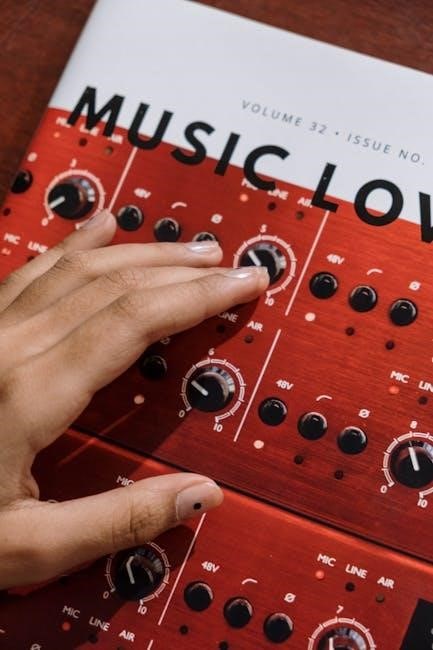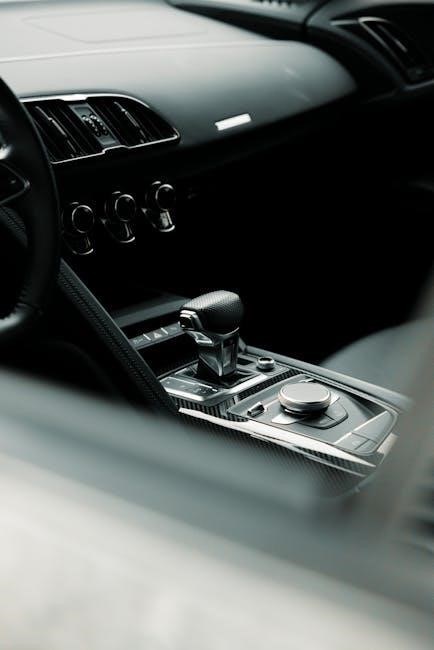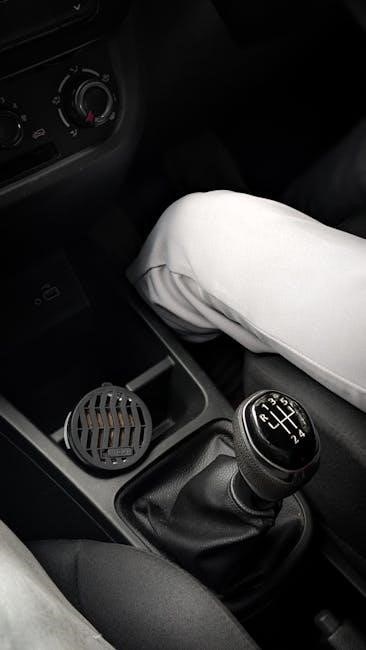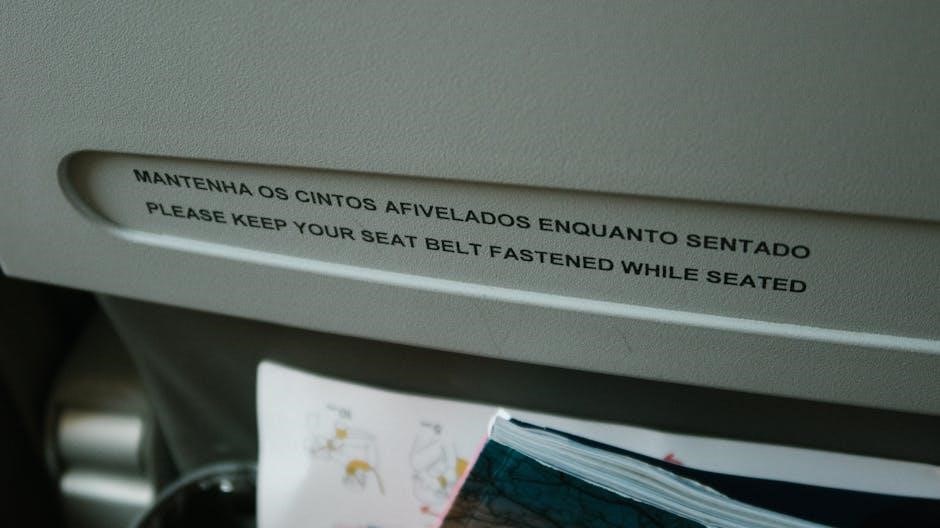Welcome to the official Nintendo Wii Console Instruction Manual. This guide provides essential information for setting up, operating, and troubleshooting your Wii console. It covers system features, safety precautions, and optimal usage tips to ensure a seamless gaming experience.
Overview of the Wii Console and Its Features
The Nintendo Wii Console is a revolutionary gaming system designed for players of all ages. It features motion-sensing controls via the Wii Remote and Nunchuk, offering an immersive gaming experience. The console supports backwards compatibility with GameCube games and accessories. Key features include the Wii Sensor Bar for accurate motion tracking, multiple connectivity options, and a family-friendly interface. The Wii also offers a wide range of games, from casual titles like Wii Sports to retro classics via the Virtual Console. Its compact design and intuitive controls make it a versatile entertainment solution for any home.
Importance of Reading the Instruction Manual
Reading the Wii Console Instruction Manual is crucial for safe and effective use of your system. It provides essential safety precautions, setup guidelines, and troubleshooting tips to ensure optimal performance. The manual helps you understand the console’s features, such as motion controls and connectivity options, while avoiding common mistakes. By following the instructions, you can prevent damage to the console or accessories and enjoy a seamless gaming experience. Regular updates and maintenance tips are also included to keep your Wii running smoothly. Take the time to review the manual thoroughly to maximize your enjoyment and protect your investment.

System Setup and Initial Configuration
This section guides you through the initial setup of your Wii console, including unpacking, connecting to your TV, and completing the quick installation process for first-time users.
Unpacking and Physical Setup of the Wii Console
Carefully unpack the Wii console, ensuring all components are included: the main unit, Wii Remote, Nunchuk, Sensor Bar, power cable, and AV cables. Place the console on a stable, flat surface, away from direct sunlight and moisture. Position the Sensor Bar above or below your TV, aligning it with the Wii Remote’s field of view for accurate motion tracking. Connect the power cable and AV cables to your TV, ensuring proper video and audio output. This setup ensures optimal performance and safety for your Wii gaming experience.
Connecting the Wii Console to Your TV
To connect the Wii console to your TV, locate the AV Multi-Out port on the Wii and attach the provided AV cable. Insert the other end into your TV’s AV input or component input, matching the color-coded connectors (yellow for video, white and red for audio). Turn on the TV and select the appropriate input channel to display the Wii menu. Ensure the cables are securely connected for optimal video and audio quality. If using a modern TV without AV ports, consider using a Wii RGB Component Cable for better picture quality. Follow on-screen instructions to complete the setup.
Quick Installation Guide for First-Time Users
Unbox your Wii console, AV cable, power cord, and Wii Remote. Connect the AV cable to the Wii’s AV Multi-Out port and the other end to your TV’s AV input. Plug in the power cord and turn on the TV, selecting the correct input channel. Insert the Wii Sports disc (if included) to begin setup. Sync the Wii Remote by opening the console’s SD card slot and pressing the sync button on the remote. Follow on-screen prompts to select your language, country, and Wi-Fi settings. Update the system software if prompted to ensure optimal performance and access to all features. Troubleshoot any connection issues by checking cable connections and TV settings.

Understanding the Wii Hardware Components
The Wii console includes the main unit, Wii Remote, Nunchuk, and Sensor Bar. These components work together to provide motion controls and immersive gaming experiences.
Wii Remote and Nunchuk Accessories
The Wii Remote and Nunchuk are essential accessories for the Wii console. The Wii Remote features motion controls, a speaker, and a D-pad, while the Nunchuk adds an analog stick and buttons for enhanced gameplay. Together, they provide precise control in games like The Legend of Zelda: Twilight Princess and Wii Sports. The wrist strap ensures safe use, and the Wii Remote Plus combines the remote and MotionPlus for improved accuracy. Both accessories are synced to the console via Bluetooth, offering a seamless gaming experience with minimal setup required.
Wii Sensor Bar and Its Functionality
The Wii Sensor Bar is a crucial component for accurate motion sensing. It emits infrared light detected by the Wii Remote, enabling precise tracking of movements. Place it above or below your TV for optimal performance. Ensure no obstacles block the line of sight. The bar is usually built into the Wii console or provided as a standalone accessory. Avoid direct sunlight or bright lights, as they can interfere with its functionality. Proper calibration ensures smooth gameplay. Refer to the manual for troubleshooting tips if the Sensor Bar malfunctions. This accessory is essential for enjoying motion-controlled games like Wii Sports and Wii Fit.
Wii Console Ports and Connectivity Options
The Wii console features multiple ports for enhanced connectivity. The AV Multi-Out port connects to your TV for high-quality video and audio. Two USB ports support peripheral devices like the Wii LAN Adapter or external storage. The SD Card Slot allows data transfer and storage of downloaded games and content. Additionally, the Wii LAN Adapter port enables wired internet connectivity for online gaming. These ports ensure seamless integration with various accessories and services, enhancing your gaming experience. Proper use of these ports is essential for optimal performance, as outlined in the manual.

Wii Remote Plus and Accessories
The Wii Remote Plus combines motion controls with a built-in sensor for precise gaming. Key accessories include the Nunchuk for analog control and the Wii Wheel for racing games. The Classic Controller offers retro gaming support, while optional accessories like the Wii MotionPlus enhance gameplay accuracy. These tools expand the Wii’s versatility and player experience.
Syncing the Wii Remote with the Console
To sync your Wii Remote Plus with the console, press the SYNC button on the Wii Remote and the SYNC button on the Wii Console. Ensure the remote is turned off before syncing. Hold the remote’s SYNC button until the LED lights flash, then release and press the console’s SYNC button. Once synced, the LED will stay lit. If using multiple remotes, repeat the process for each. Ensure no other electronic devices interfere during syncing. This process ensures proper connectivity and optimal performance for your Wii Remote Plus.
Using the Wii Remote Plus for Enhanced Gameplay
The Wii Remote Plus combines motion controls and traditional button inputs for enhanced gameplay. Use the D-pad and buttons for navigating menus and executing commands. The built-in MotionPlus technology provides precise motion sensing, ideal for sports and action games. Shake, tilt, or swing the remote to interact with games intuitively. Hold the remote with the D-pad facing up for classic gameplay or sideways for retro titles. Press the A button to select options and the Home button to access settings; This versatile design ensures a dynamic and immersive gaming experience across various Wii titles.
Optional Accessories and Their Setup
Enhance your Wii experience with optional accessories like the Wii LAN Adapter for wired internet connections, or an SD Card for storing game data and downloads. The Classic Controller is ideal for retro games, while the Wii Wheel adds realism to racing games. To set up, connect the LAN Adapter to the Wii’s USB port and configure settings via the Wii Menu. Insert SD Cards into the slot on the front of the console. Plug the Classic Controller into the Wii Remote’s accessory port. These accessories expand functionality and customization, ensuring a tailored gaming experience for all users.

Navigating the Wii User Interface
The Wii Menu is designed for simplicity, featuring a clean, channel-based interface. Use the Wii Remote to navigate through options like the Disc Channel, Mii Channel, and Wii Shop Channel. The Home button provides quick access to settings and game information, while the pointer function allows intuitive browsing. This user-friendly design ensures easy access to all console features and functions.
Wii Menu Overview and Navigation
The Wii Menu is a user-friendly interface designed for easy navigation. It features a series of channels, including the Disc Channel, Mii Channel, Wii Shop Channel, and Photo Channel. Use the Wii Remote’s pointer to select options by aiming at icons and pressing the A button. The Wii Menu allows access to games, settings, and multimedia features. The Home button on the Wii Remote provides quick access to menu options and game information. This intuitive design ensures a smooth and enjoyable experience for users of all skill levels, making it easy to explore and utilize the Wii’s features.
Channels and Their Functions
The Wii Menu features multiple channels, each designed for specific functions. The Disc Channel launches games from Wii discs, while the Mii Channel allows creation and management of Mii characters. The Wii Shop Channel enables downloading of Virtual Console games and WiiWare titles. The Photo Channel organizes and displays photos stored on the console. Additional channels like News and Weather provide real-time updates, and the Wii Settings channel offers system configuration options. These channels streamline access to various features, enhancing user convenience and personalization. They are easily navigable using the Wii Remote, ensuring a user-friendly experience.
Home Menu Features and Customization
The Home Menu on the Wii console serves as a central hub for accessing games, channels, and system settings; Pressing the Home button on the Wii Remote brings up the Home Menu, which displays your currently inserted disc, downloaded channels, and saved data. You can customize the layout by rearranging channels using the Wii Remote’s directional buttons. The menu also provides quick access to Wii Settings for adjusting system preferences, such as screen resolution or parental controls. Additionally, the Home Menu allows you to manage saved data, check for system updates, and access online features, making it a versatile tool for enhancing your gaming experience.

Setting Up the Wii for Online Play
To connect your Wii Console to the internet, access System Settings and select Internet. Follow on-screen instructions to configure your network settings. Ensure a stable connection for online features like the Wii Shop Channel. Refer to the manual for troubleshooting tips.
Connecting the Wii Console to the Internet
To connect your Wii Console to the internet, navigate to the System Settings menu. Select Internet and choose your network from the list of available options. Enter your Wi-Fi password if prompted. For wired connections, use an Ethernet cable and select the appropriate option. Once connected, you can access online features like the Wii Shop Channel. If issues arise, ensure your router is nearby and restart both the Wii and router. Refer to the manual for detailed troubleshooting steps to resolve connectivity problems and optimize your online experience.
Configuring Wii Shop Channel and Online Services
To configure the Wii Shop Channel and online services, navigate to the Wii Shop Channel from the Wii Menu. Select Start and review the terms of service, then select Agree. Create or link a Nintendo Account if prompted. Use a credit card or purchase Wii Points to download games and content. Once configured, you can browse and purchase games, DLC, and other digital content. Ensure your internet connection is stable for smooth downloads. For further assistance, refer to the Wii Shop Channel guide within the manual or visit Nintendo Support online.
SD Card Usage for Data Management
The Wii console supports SD and SDHC cards for data management, allowing you to store game saves, downloaded content, and WiiWare titles. Insert the SD card into the SD card slot on the front of the console. Ensure the card is formatted to FAT32 for compatibility. Use the Wii Menu to manage data, transfer files, and organize content. Some games may require an SD card for specific features. Always eject the card safely via the menu to prevent data loss. For detailed instructions, refer to the Wii manual or visit Nintendo Support online.

Gameplay Instructions and Controls
The Wii Remote offers intuitive motion controls, while the Nunchuk enhances gameplay with analog stick functionality. Use the Classic Controller for retro games, ensuring precise control and a classic feel.
Basic Gameplay Controls and Wii Remote Functions
The Wii Remote is designed for intuitive motion controls, allowing precise movements in games. Use the D-pad and buttons for menu navigation and basic commands. The Nunchuk attachment adds an analog stick and extra buttons for enhanced control. To access in-game instructions, press the Home button on the Wii Remote. Ensure the Sensor Bar is properly aligned for accurate motion sensing. For optimal performance, hold the Wii Remote firmly and maintain a clear line of sight with the console. Regularly check battery levels to avoid interruptions during gameplay.
Using the Classic Controller for Retro Games
The Classic Controller is designed for playing Virtual Console games, offering a traditional layout for retro gaming. Attach it to the Wii Remote for a comfortable grip. Use the D-pad for directional control and the A/B buttons for actions. Shoulder buttons enable additional functions, while the Home button pauses the game. The Classic Controller supports both horizontal and vertical layouts for optimized play. Ensure proper synchronization with the Wii console before use. For specific button mappings, refer to the game’s manual via the Virtual Console menu. This accessory enhances your retro gaming experience on the Wii.
Virtual Console Games and Their Setup
To enjoy Virtual Console games on your Wii, start by connecting your console to the internet to access the Wii Shop Channel. Purchase Wii Points to buy classic titles from various retro consoles like NES, SNES, and more. After purchasing, games download to your Wii’s internal memory. For optimal play, use the Classic Controller, which mimics retro control layouts. Access downloaded games via the Wii Menu as new channels. Manage storage by deleting and redownloading games as needed. For gameplay instructions, refer to manuals accessible via the game’s menu or the Wii Shop Channel.

Troubleshooting Common Issues
Address common problems like connectivity issues, syncing errors, or console freezing by consulting the manual or Nintendo’s official support website for detailed solutions and guidance.
Resolving Connection Problems
If you encounter connection issues with your Wii console, ensure all cables are securely connected to both the console and your TV. Check for loose connections, as this is a common cause of problems. Restart your Wii and router to reset the connection. Verify that your TV is set to the correct input channel. If issues persist, refer to the manual for troubleshooting steps or contact Nintendo support for further assistance. Regularly updating your system software can also help resolve connectivity problems and improve overall performance.
Fixing Wii Remote Syncing Issues
To resolve Wii Remote syncing issues, first ensure the remote is turned on and batteries are not low. Press and release the SYNC button on the Wii console and then on the remote. If syncing fails, restart the console and try again. Check for interference from other devices. Replace batteries if they are weak. If issues persist, reset the Wii Remote by pressing the SYNC button for 15 seconds. Ensure the Sensor Bar is properly connected and positioned. For further assistance, consult the Wii Operations Manual or contact Nintendo support.
Addressing Console Freezing or Lag
If your Wii console freezes or experiences lag, restart the system by turning it off, waiting 30 seconds, and turning it back on. Ensure proper ventilation to prevent overheating. Check for corrupted game data by deleting and reinstalling the affected game or channel. Use the Wii System Memory option to manage stored data. If issues persist, update the Wii system software to the latest version. For severe lag, reset the Wii to default settings via the Wii Settings menu. If problems continue, contact Nintendo Support for further assistance or potential hardware evaluation.

Maintenance and Care for the Wii Console
Regularly clean the Wii console and accessories with a soft cloth. Avoid exposure to extreme temperatures or moisture. Store the Wii in a well-ventilated area when not in use. This ensures optimal performance and longevity of your Wii system.
Cleaning the Wii Console and Accessories
To maintain your Wii console and accessories, use a soft, dry cloth to wipe away dust and dirt. Avoid harsh chemicals or liquids, as they may damage the finish or harm internal components. For stubborn marks, lightly dampen the cloth with water, but ensure it is not soaking wet. Gently clean the Wii Remote’s buttons and surfaces, avoiding the IR sensor and any openings. Allow all components to dry completely before use. Regular cleaning prevents dust buildup and ensures optimal performance. Never submerge any part of the Wii system in water or expose it to excessive moisture.
Preventing Damage to the Wii Console
To prevent damage to your Wii console, avoid exposing it to extreme temperatures, moisture, or physical stress. Use only Nintendo-authorized accessories to ensure compatibility and safety. Keep the console away from direct sunlight and avoid stacking objects on top of it. Prevent overheating by ensuring proper ventilation around the unit. Handle the Wii Remote with care, as drops or impacts can damage internal components. Store the console and accessories in a dry, cool place when not in use. Avoid touching the lens of the Wii Disc drive to prevent scratches. Regularly inspect cords and cables for wear or damage. Always unplug during lightning storms to protect against power surges. By following these guidelines, you can extend the lifespan of your Wii system and maintain its performance.
Updating Wii System Software
Regularly updating your Wii system software ensures optimal performance, new features, and bug fixes. To update, connect your Wii to the internet, go to the Wii Settings, and select Wii System Update. Follow on-screen instructions to download and install the latest version. Updates may improve compatibility with games and accessories, enhance online functionality, and address security issues. Always use a stable internet connection during updates to avoid interruptions. Keeping your Wii software up-to-date is essential for a smooth and secure gaming experience. Refer to the Wii Menu for detailed update instructions and release notes.

Safety Precautions and Health Warnings
Ensure the Wii console is used in a well-ventilated area, away from water and direct sunlight. Avoid exposing the console to extreme temperatures or moisture. Caution: The Wii Remote and console emit radio waves that may interfere with pacemakers or other medical devices. Maintain a safe distance and follow all health guidelines provided in the manual.
Important Safety Information
Read this section carefully to ensure safe and proper use of your Wii console. The Wii console and Wii Remote emit radio waves that may interfere with medical devices like pacemakers. Keep the Wii Remote away from children under 3 years old, as small parts may pose a choking hazard. Avoid exposing the console to water, direct sunlight, or extreme temperatures. Handle the Wii Remote with care to prevent damage or injury. Always use approved Nintendo accessories to maintain safety and performance. Follow all instructions in this manual and take regular breaks during extended play sessions to avoid fatigue.
Health Warnings for Wii Remote Use
Use the Wii Remote responsibly to ensure a safe gaming experience. Prolonged use may cause fatigue or discomfort. Take regular breaks to avoid eye strain and repetitive motion injuries. The Wii Remote emits radio waves, which may interfere with certain medical devices like pacemakers. Keep the remote out of reach of children under three due to small parts. Do not use the remote near flammable materials or in hazardous environments. Follow all safety guidelines in this manual and consult a healthcare professional if discomfort persists during or after use. Proper usage ensures enjoyable and injury-free gaming sessions for all players.
Explore all features, maximize your gaming experience, and refer to this manual for troubleshooting. Regularly update your system and visit Nintendo’s support site for the latest assistance and enhancements.
Maximizing Your Wii Console Experience
To fully enjoy your Wii console, explore its diverse features and accessories. Regularly update your system software for optimal performance and access to new features. Utilize the Wii Shop Channel to download classic and WiiWare games, enhancing your gaming library. Experiment with various controllers like the Wii Remote Plus and Classic Controller for different gameplay experiences. Organize your data using SD cards and ensure proper maintenance by cleaning the console and accessories. Stay connected with Nintendo’s support for troubleshooting and updates, ensuring your Wii remains a hub for entertainment and fun.
Staying Updated with Nintendo Support
Regularly check for system updates to ensure your Wii console performs optimally. Visit the official Nintendo website for the latest software updates, troubleshooting guides, and downloadable content. Explore the Wii Shop Channel for new games and features. For assistance, refer to Nintendo’s support resources, including FAQs and user manuals. Stay informed about safety guidelines and maintenance tips to prolong your console’s lifespan. By keeping your Wii updated and well-maintained, you can enjoy a seamless and enhanced gaming experience. Visit Nintendo’s official website for the latest information and support.

